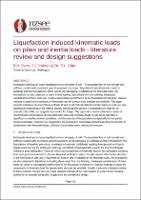Liquefaction induced kinematic loads on piles and inertia loads - literature review and recommendations for design

Download
Date
2023-04-19Authors
Rama, Bhavesh
Palmer, Stuart
Chin, Eng Liang
Metadata
Show full item recordAbstract
Earthquake shaking can cause soil liquefaction in certain types of soil. The associated loss of soil strength and stiffness coupled with any lateral ground movement can be damaging to buildings and their foundations. Pile foundations in liquefied ground can be subject to kinematic (soil) loads resulting from ground lurch/cyclic displacement (during the earthquake shaking), and lateral spread (typically towards the end of earthquake shaking or post-earthquake). There are three main components of kinematic load on the foundations resulting from such ground movement. 1) the non-liquefied soil load (crust) on the pile cap; 2) the crust load on pile; and 3) liquefied soil load on pile. In addition to the kinematic loads, the foundations are also subjected to lateral loading (base shear) from the building. Inadequate consideration of these loads can result in unacceptable performance of the foundation and structure. Various methods to assess the components of kinematic load for pseudo-static analyses are available. This paper presents a literature review of these methods. It was found that calculated kinematic loads on a pile can vary significantly depending on the method chosen, and soil profile present. Comparisons are made for two example soil profiles, and recommendations provided on factors to consider for design. This paper also presents a literature review of combinations of concurrent base shear and kinematic loads. Recommendations are provided on appropriate percentages of peak base shear to consider in combination with kinematic loads during the cyclic displacement and lateral spread stages of ground movement, based on various considerations.
